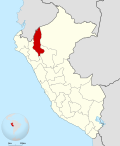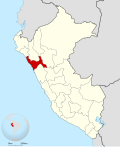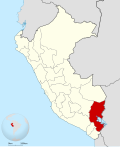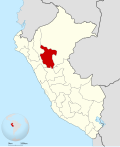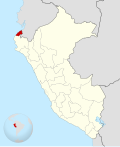The departments (Spanish : departamentos), informally called regions (Spanish : regiones), are the first-level administrative subdivisions of Peru. According to the Organic Law of Regional Governments, each department is administered by a regional government and a legislature responsible for administration, economic planning, and public services. These governments operate with autonomy while still coordinating with national authorities. Each department is led by a regional governor, who is elected by popular vote for a four-year term, and is responsible for implementing regional policies, managing budgets, and overseeing infrastructure projects. The governor is supported by a regional legislative council, composed of elected representatives from different provinces within the department. This council approves budgets, monitors public investments, and ensures government accountability.
Contents
- History
- 1989 regions
- Later history
- Government
- Regions
- Former departments
- See also
- Notes
- References
- Sources
There are 24 departments in total, as well as two provinces that operate under a special regime: Callao and Lima. The former does not belong to any department since 1836, but is nevertheless administered by a regional government of its own. The latter is administered by the Metropolitan Municipality of Lima, which is equal in status to a regional government. [1] [2]
Each department is further divided into provinces, which are governed by provincial municipalities. These municipalities are led by a mayor and a council, also elected by the population. They manage local services such as urban planning, transportation, and sanitation. Within the provinces, there are district municipalities, responsible for more localized governance, including community development, minor public works, and social programs. This three-tiered structure—regional, provincial, and district—ensures that governance reaches all levels, from large cities to rural villages.
Although the departments have autonomy, they still follow national laws and policies set by the central government. The National Decentralized Secretariat (Spanish : Secretaría de Descentralización), under the Presidency of the Council of Ministers, oversees regional governments to ensure efficiency and compliance. Departments also coordinate with national ministries for education, health, transportation, and security, receiving funding and technical support. This structure allows departments to manage their own affairs while maintaining a connection to the broader national development strategy.



